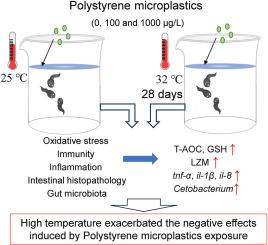高温条件下暴露于聚苯乙烯微塑料的牛蛙蝌蚪(Lithobates catesbeiana)肠道损伤和微生物失衡加剧
IF 7.3
2区 环境科学与生态学
Q1 ENVIRONMENTAL SCIENCES
引用次数: 0
摘要
微塑料污染对生态系统构成的潜在威胁已经引起了广泛关注。此外,气候变暖和环境污染物的共同作用可能进一步加剧对水生生物的负面影响。本研究系统评价了聚苯乙烯微塑料(PS-MPs)在不同温度下对牛蛙蝌蚪(Lithobates catesbeiana)氧化应激状态、炎症反应和肠道菌群组成的影响。采用组织学分析、各种生物标志物和微生物组方法。将蝌蚪在25℃和32℃条件下分别暴露于0(对照)、100和1000 μg/L的PS-MPs中28天。结果表明,与低温条件相比,高温条件下PS-MP暴露显著提高了肠道总抗氧化能力、谷胱甘肽、酸性磷酸酶和溶菌酶水平。此外,在32°C下暴露PS-MP显著破坏肠上皮细胞结构,增加促炎因子基因的表达水平。肠道菌群分析表明,随着PS-MPs浓度的增加,Cetobacterium的丰度不断增加。高温条件下,PS-MP暴露进一步导致微生物群落多样性下降。这些结果表明,高温环境加剧了PS-MP暴露的负面影响,增强了牛蛙蝌蚪肠道的氧化应激和炎症反应,这可能是导致肠道微生物群失调的主要因素。本研究为评估微塑料的环境风险和制定相应的环境保护措施提供了科学依据,凸显了在全球变暖背景下应对复合环境压力的紧迫性。本文章由计算机程序翻译,如有差异,请以英文原文为准。


Enhanced gut damage and microbial imbalance in bullfrog tadpoles (Lithobates catesbeiana) exposed to polystyrene microplastics under high-temperature conditions
The potential threat posed by microplastic pollution to ecosystems has garnered widespread attention. Additionally, the combined effects of climate warming and environmental pollutants may further exacerbate the negative impacts on aquatic organisms. In this study, the effects of polystyrene microplastics (PS-MPs) on the oxidative stress status, inflammatory response, and gut microbiota composition of bullfrog tadpoles (Lithobates catesbeiana) were systematically evaluated under different temperatures. Histological analysis, various biomarkers, and microbiome methods were used. Tadpoles were exposed to 0 (control), 100, and 1000 μg/L of PS-MPs at both 25 °C and 32 °C for 28 days. The results showed that compared to low-temperature conditions, PS-MP exposure under high-temperature conditions significantly increased the total antioxidant capacity, glutathione, acid phosphatase, and lysozyme levels in the gut. Additionally, PS-MP exposure under 32 °C significantly disrupted the intestinal epithelial cell structure and increased the expression levels of pro-inflammatory factor genes. Gut microbiota analysis showed that the abundance of Cetobacterium continuously increasing with the concentration of PS-MPs. Under high-temperature conditions, PS-MP exposure further led to a decrease in microbial community diversity. These findings indicate that high-temperature environments exacerbate the negative effects of PS-MP exposure and enhance the oxidative stress and inflammatory response in the intestines of bullfrog tadpoles, which may be the primary factor leading to gut microbiota dysbiosis. This study provides scientific evidence for assessing the environmental risks of microplastics and formulating corresponding environmental protection measures, highlighting the urgency of addressing combined environmental stressors in the context of global warming.
求助全文
通过发布文献求助,成功后即可免费获取论文全文。
去求助
来源期刊

Environmental Pollution
环境科学-环境科学
CiteScore
16.00
自引率
6.70%
发文量
2082
审稿时长
2.9 months
期刊介绍:
Environmental Pollution is an international peer-reviewed journal that publishes high-quality research papers and review articles covering all aspects of environmental pollution and its impacts on ecosystems and human health.
Subject areas include, but are not limited to:
• Sources and occurrences of pollutants that are clearly defined and measured in environmental compartments, food and food-related items, and human bodies;
• Interlinks between contaminant exposure and biological, ecological, and human health effects, including those of climate change;
• Contaminants of emerging concerns (including but not limited to antibiotic resistant microorganisms or genes, microplastics/nanoplastics, electronic wastes, light, and noise) and/or their biological, ecological, or human health effects;
• Laboratory and field studies on the remediation/mitigation of environmental pollution via new techniques and with clear links to biological, ecological, or human health effects;
• Modeling of pollution processes, patterns, or trends that is of clear environmental and/or human health interest;
• New techniques that measure and examine environmental occurrences, transport, behavior, and effects of pollutants within the environment or the laboratory, provided that they can be clearly used to address problems within regional or global environmental compartments.
 求助内容:
求助内容: 应助结果提醒方式:
应助结果提醒方式:


